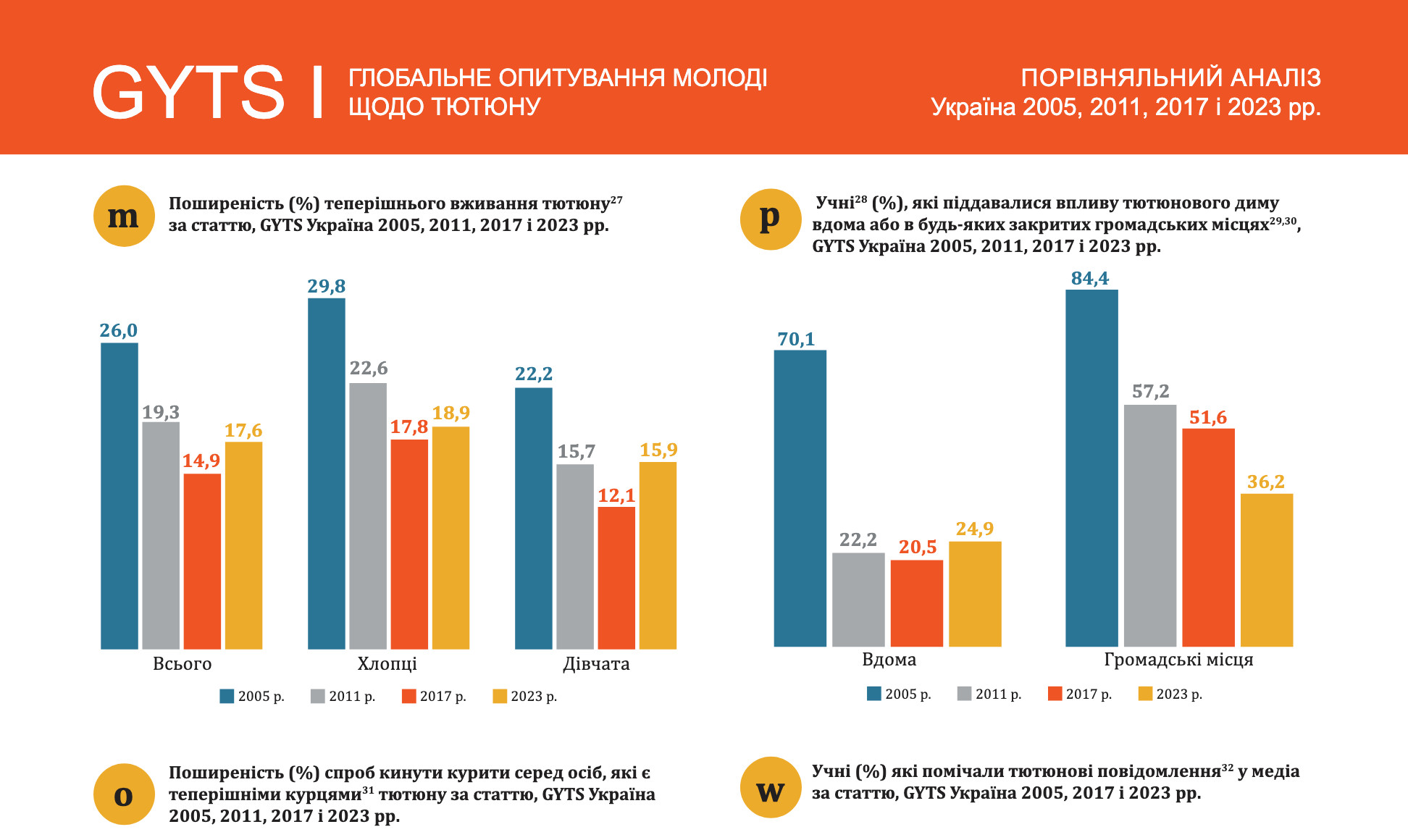Patterns of nicotine product use among adolescents before the start of military aggression

In 2017, Ukraine carried out the fourth wave of the Global Youth Tobacco Survey (GYTS) among 13–15-year-old schoolchildren. Analysis of the survey results among adolescents in different regions of Ukraine revealed certain regional patterns. The proportion of children who have tried smoking regular cigarettes is highest in the eastern region (55.2%) and in Kyiv (30.1%), regardless of gender. The proportion of children who have tried smoking regular cigarettes is highest in the eastern region (55.2%) and in Kyiv (30.1%), regardless of gender, and lowest in the western region. The proportion of children who smoked electronic cigarettes was 18.4% (boys – 22.6%, girls – 14.0%), which is twice the proportion of daily smokers of regular cigarettes – 9.2% of respondents (10.8% of boys and 7.7% of girls). In other words, Ukraine saw a higher prevalence of e-cigarette smoking than regular cigarette smoking, which is generally in line with European and global trends [WHO Report on the Global Tobacco Epidemic, 2021].
The latest large-scale survey of Ukrainian children aged 14-17 (i.e., born in 2001-2004) was carried out as part of a pan-European study on smoking, alcohol, and drug use (ESPAD) in 2019. The authors report that although there is a downward trend in cigarette smoking among children in Ukraine, the survey results show that it remains widespread. Half (50.5%) of the participants reported that they had tried smoking at least once in their lives, and 10.2% of boys tried their first cigarette before the age of 9. One in five (19.6%) children reported smoking daily; this proportion was higher among boys than girls (23% versus 16.5%, respectively). In the 30 days prior to the survey, 11.7% of children had smoked electronic cigarettes (15.4% of boys and 8.3% of girls). Hookah use was relatively common among all respondents, but was more common among girls (33.8%) than boys (30.5%). Overall, 43.8% of respondents said that it was easy for them to obtain cigarettes, and 50.1% of adolescents in regional centers also noted the easy availability of cigarettes. Only 17.1% of respondents believed that people who occasionally smoke cigarettes are at high risk of negative health effects, and more than half (59.7%) believed that heavy smoking (i.e., one or more packs of cigarettes per day) poses a risk to their health [Dobryanska O.V., 2019].
The results of a survey of high school seniors and first- and second-year students at higher education and vocational schools showed that in 2013–2014, compared to 2009–2010, there was a decrease in the prevalence of smoking, which was more pronounced among girls (from 22% to 13%) than among boys (from 26% to 22%) [Balakireva O.M., Pavlova D.M., Nguyen N-M.K., 2019].
The decline in the prevalence of traditional cigarette smoking among young people in our country occurred against the backdrop of the growing popularity of alternative types of smoking. These include electronic cigarettes (e-cigarettes, vapes), tobacco heating devices (IQOS), and in some cases, products with reduced tobacco content (snuff, chewing tobacco, etc.) [Dobrovolska L.I., Boyarchuk O.R., 2020].
The world’s leading tobacco companies, gradually losing users of traditional cigarettes, are looking for new ways to win over smoking enthusiasts. In particular, smoking e-cigarettes is positioned as a means of gradually getting rid of a harmful habit, which is supposedly less harmful to health due to the lower doses of nicotine in these smoking devices. European users cite the following main reasons for using e-cigarettes: they are less harmful than conventional cigarettes (51% of respondents); smoking e-cigarettes helps to gradually quit smoking conventional cigarettes (49%); there is no unpleasant smell when smoking such cigarettes (46%); they can be used in places where smoking tobacco is prohibited (42%) [Cherian S.V., Kumar A., Estrada-Y-Martin, 2020].
Head of the Laboratory of the Safety of Children’s Population Vital Functions,
Doctor of Medical Sciences
Alina PLATONOVA
State Institution «Marzieiev Institute for Public Health of the National Academy of Medical Sciences of Ukraine»
(date of publication on the website 22.09.2025)